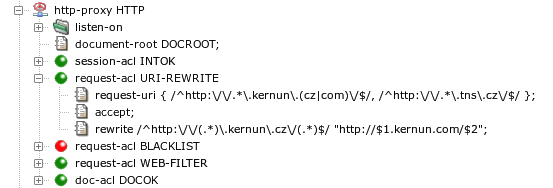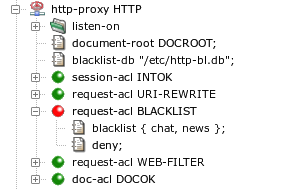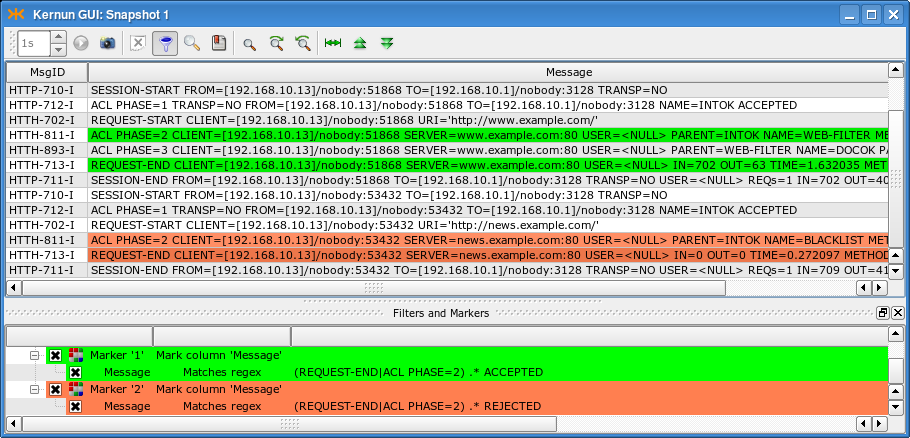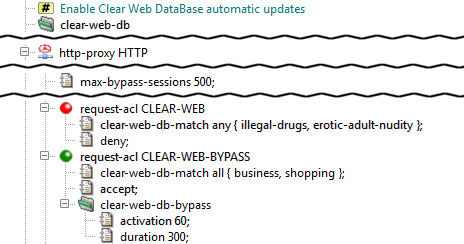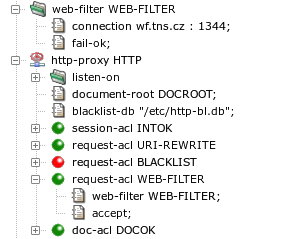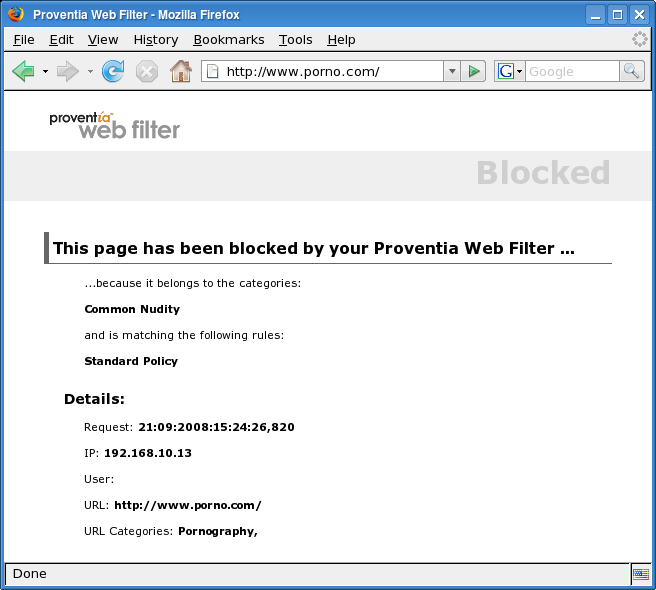Kernun UTM's HTTP proxy provides several methods that can be used to change
requestURIs passed to servers and make decisions based on URIs. A URI can be
matched against regular expressions, searched in a local database
(blacklist), or evaluated by the Kernun Clear Web DataBase or by an
external Web filter. The sample configuration
/usr/local/kernun/conf/samples/cml/url-filter.cml
contains an HTTP proxy with all URI filtering methods.
An example of the HTTP proxy that matches HTTP requests by the
request URI is depicted in Figure 5.71, “Request URI matching and rewriting”. If a request URI
matches one of the regular expressions in the string specified in the
request-uri item of
request-acl URI-REWRITE, this ACL will be selected.
It accepts the request and applies the rewrite item(s). There
can be several rewrite items. Each of them contains
a regular expression and a string. A request URI that matches the regular
expression in a rewrite clause will be rewritten to the
string. Pairs of characters dollar+digit ($1,
$2…) in the string will be replaced by parts
of the original URI matched by parenthesized parts of the regular
expressions. The rewrite item in Figure 5.71, “Request URI matching and rewriting” matches any URI containing
kernun.cz and rewrites cz to
com, leaving the rest of the URI unchanged.
In a request-acl, there are two more types of
URI-matching conditions. We have already seen
request-uri, which matches the whole URI. The other
conditions are: request-scheme (matches the scheme part
of the URI) and request-path (matches the path part of
the URI).
Figure 5.72, “Log of URI matching and rewriting” shows a log of an HTTP proxy
running with the configuration from Figure 5.71, “Request URI matching and rewriting” and
processing a request with URI http://www.kernun.cz/.
The two most important messages are marked. The
HTTH-811-I message informs that
request-acl URI-REWRITE was selected. The following
message confirms that the URI was rewritten to
http://www.kernun.com/.
A security policy may require to deny access to large groups of Web
servers. Adding a very large number of servers to
a request-acl.request-uri item may slow down ACL
processing significantly. A better strategy is to create
a blacklist of forbidden servers in a special
format processed more efficiently by the HTTP proxy. A blacklist must be
prepared in a text file in the format described in
mkblacklist(1). The textual blackist is then
transferred to a binary form usable by the HTTP proxy by utilities
resolveblacklist(1) and
mkblacklist(1). A binary blacklist file can be
converted back to the text format by
printblacklist(1).
A blacklist contains a list of Web server addresses (domain
names or IP addresses) with an optional initial part of a request path.
A list of categories is assigned to each address. It is possible to select
a request-acl based on a matching
blacklist item with the set of categories assigned to the
request URI by the blacklist.
An HTTP proxy will use the blacklist database file specified by
blacklist-db in the http-proxy section,
see Figure 5.73, “A blacklist in the HTTP proxy”. If a request URI belongs to
the category chat or news, then
request-uri BLACKLIST will be selected and the
request will be denied. Other requests will be processed according to
request-uri WEB-FILTER, described in the next
section.
Note
If a proxy runs in chroot, the path
blacklist-db will be interpreted in the context of the
chroot directory.
A log of an HTTP proxy configured according to Figure 5.73, “A blacklist in the HTTP proxy” is displayed in Figure 5.74, “A log of blacklist usage in the HTTP proxy”. The log messages are related to two
requests. The first request to server www.example.com does not match
categories selected in request-acl BLACKLIST and the
request is accepted by request-acl WEB-FILTER. The
second request to
news.example.com matches
a category from request-acl BLACKLIST, which rejects
the request. Note the ACL names reported in
ACL PHASE=2 messages and the log
markers that colorize accepting and rejecting messages.
Continuous updating of a blacklist so that it covers as many prospective unwanted Web servers as possible is a challenging task, greatly exceeding the capabilities of a typical company network administrator. Therefore, there are commercially available services that provide regularly updated databases of Web servers classified into many categories according to content. Kernun UTM contains one such service—the Kernun Clear Web DataBase.
Configuration of the Kernun Clear Web DataBase consists of two parts. One is used to detect URL categories and select ACLs according to the categories, the other deals with updating of the database of URLs.
The Clear Web DataBase takes a request URI and assigns to it a set
of categories. The categories can be matched by item
request-acl.clear-web-db-match in the process of
request-acl selection during an HTTP request processing.
Two examples of sections request-acl with condition
clear-web-db-match are shown in Figure 5.75, “Kernun Clear Web DataBase in the HTTP proxy”. There are three possible modes of
category matching, selectable in each condition item:
any— at least one category of the request URI matches the set of categories in the condition;all— all categories in the condition are contained in the set of categories which the request URI belongs to;exact— the request URI belongs to all the categories from the condition and does not belong to any additional category.
If the selected request-acl contains
a clear-web-db-match condition
(CLEAR-WEB in the sample configuration) and the
deny item, the proxy will return an error HTML page
containing information that the request has been denied by the Clear Web
DataBase and the list of matching categories.
As an alternative to denying a request URI matching given categories
absolutely, the proxy provides the bypass feature, a
sort of “soft deny”. It is activated by item
request-acl.clear-web-db-bypass (used in
CLEAR-WEB-BYPASS in the sample configuration). When
a user attempts to access a Web server restricted by the bypass, an error
page is returned by the proxy, containing a link, through which
the user can obtain limited-time access to the requested server and all
Web servers that belong to the same categories. After the bypass
expiration time, which can be changed using item duration,
the error page will be displayed again. The user can then reactivate the
bypass. Each bypass activation is logged.
Bypass sessions activated by users are tracked by an internal
table managed by the proxy. The maximum number of simultaneously active
bypass sessions is controlled by
http-proxy.max-bypass-sessions. If this number is set to
0, the number of bypass sessions will become unlimited, and the sessions
will be tracked by cookies. In this case, an activated bypass is valid for
the target server and all servers in the same domain, but not for other
servers, even if they belong to the same categories.
Clients often use the HTTP proxy also for access to intranet WWW
servers. These internal servers can be located in the internal network,
using private IP addresses from ranges defined by RFC 1918 (networks
10.0.0.0/8, 172.16.0.0/12, and 192.168.0.0/16). Or they may be accessible
from the Internet, but restricted to internal users.
Such internal servers are not contained in the Clear Web DataBase
and would be categorized as unknown. In order to
distinguish internal servers from public web servers with unknown
categories, host names or IP addresses of the internal servers can be
listed in the configuration by item
clear-web-db.internal-servers. Private IP addresses from
RFC 1918 are included by specifying
internal-servers private-ip, so they need not be
written explicitly.
If a server from an HTTP request matches some element of the list of
internal servers, it will be assigned category
internal-servers. This category is not used for any
public web server included in the standard Clear Web DataBase.
The Clear Web DataBase file location in controlled by
clear-web-db.db, which defaults to
/data/var/clear-web-db if not set. The database
file is copied (or hardlinked, if possible) automatically to any chroot
directories by the database update script and when the configuration is
applied.
Although it is possible to update the Clear Web DataBase data manually
by copying an updated clear-web.db file to the database
directory, it is recommended to use the provided update script
clear-web-db-update.sh for this purpose. It downloads the most
appropriate full database and/or applies any incremental updates to get the
most recent version of the database, minimizing the amount of downloaded data.
To use this feature, you need to have valid download credentials. These are
configured by clear-web-db.credentials.
If not set, the serial number from the license file is used as both
the username and the password.
The Clear Web DataBase data update script can be executed either
manually by running clear-web-db-update.sh from the root
console (Kernun console in the GUI), or automatically by cron in periodic
intervals. Periodic updates are enabled by placing the clear-web-db
(usually empty) section in the system configuration.
If no record is found for a requested URL in the Clear Web DataBase, the “unknown” result is reported and matched in ACLs. A valid list of categories will be returned for repeated requests to the same URL only after the server becomes a part of the Clear Web DataBase downloaded in some future update. As an option, there is a faster way how to obtain categories for servers not yet known. It is possible to enable the cwcatd daemon that performs automatic local categorization of web pages.
If categories for a requested URL are not found in the Clear Web DataBase, the URL is appended to a queue that is processed by daemon cwcatd. The daemon reads uncategorized URLs from the queue. For each URL, it tries to download the referenced web page. The downloaded page is passed to an automatic categorizer, which tries to assign categories according to heuristics applied to the page content. If it succeeds, the result is stored in a local database. Future requests to a locally categorized server will get categories assigned according to the local database. If categories of the server appear in the downloaded Clear Web database in its periodic update, the result of the automatic local categorization will not be used any more.
Categories discovered automatically by the cwcatd daemon are not as correct and reliable as the contents of the Clear Web DataBase maintained by experienced human operators. But on the other hand, results of the automatic categorization are available almost immediately after the access to a web page with unknown categories.
Automatic categorization of web servers is enabled by adding
subsection local-db to the configuration section
clear-web-db. It instructs the
http-proxy and the icap-server to
enqueue URLs with unknown categories for processing by
cwcatd and to use the results of automatic
categorization. The cwcatd daemon is enabled by adding
section cwcatd.
The Clear Web DataBase or the local database contain the following set of categories:
- Advertisement
Advertising agencies, servers providing advertising banners
- Alcohol / Tobacco
Alcohol, tobacco, breweries
- Arts
Galleries, theaters, exhibitions
- Banking
Banks, Internet banking
- Brokers
Stock exchange information, stocks purchase and sale
- Building / Home
Construction, architecture, e-shops with construction materials and equipment
- Business
Corporate websites, offering actual services and products, Web pages referring to companies (parked domains)
- Cars / Vehicles
Web pages of motorists, motorcyclists, aviators, sailors, producers, vendors and enthusiasts of transportation vehicles
- Chats / Blogs / Forums
Chats, personal blogs, discussion forums
- Communication
Information and communication technology, services of Internet providers, telephone operators, SMS gateways, phonebooks
- Crime
Committing crime, crime protection
- Education
Education, science, research
- Entertainment
Entertainment and sports centers
- Environment
Weather forecasts, live webcams, environment protection, ecology
- Erotic / Adult / Nudity
Erotic acts, half-naked up to naked bodies, erotic tales
- Extreme / Hate / Violence
Attacks against individuals or groups of people, deviations (sadism, masochism, etc.), violence on humans or animals
- Fashion / Beauty
Clothing, body care, make-up
- Food / Restaurants
Restaurants, recipes
- Foundations / Charity / Social Services
Help to handicapped, addicted, underprivileged people or people with special needs, families and children
- Gambling
Gambling for money
- Games
Online and offline games
- Government
Government organizations, agencies, ministries, communes
- Hacking / Phishing / Fraud
Web pages of cracking groups, malicious software, exploitation guides. Does not include anti-hacking and anti-phishing protection
- Health / Medicine
Electronic pharmacies, hospitals, relaxation, massage, spa
- Hobbies
Thematic hobby/interests pages
- Humor / Cool
Humor, jokes, pranks
- Illegal Drugs
Drugs, narcotics
- Instant Messaging
Real-time message transfer
- Insurance
Insurance companies
- Internal Servers
Internal web server, includes private (RFC 1918) IP addresses and servers declared as internal in the configuration
- IT / Hardware / Software
Hardware and software retail, service, support
- IT Services / Internet
IT and Internet products, services, domain names
- Job / Career
Human resource agencies, job offers
- Kids / Toys / Family
Advice, instructions, websites for kids and family
- Military / Guns
Historic information, army-shops
- Mobile Phones / Operators
Mobile phones and accessories, telephone operators
- Money / Financial
General financial consultancy, financial servers
- Music / Radio / Cinema / TV
Web pages of music bands, pages about music and movies, TV guides, cinema programme
- News / Magazines
Live news, tabloids, journals. Does not include Web pages aggregating news from other sources
- Peer-to-peer
Peer-to-peer networks for data transfer (software, music, movies)
- Personal / Dating / Live Styles
Personal Web pages, pages of musicians and bands, gossips
- Politics / Law
Web pages of political parties, pages about politics and law
- Pornography
Videos for download, photos, e-shops
- Portals / Search Engines
Internet search engines, covering either a large number of areas or specific fields. Does not include Web pages searching their own site only
- Proxies
Servers that provide access to other Web pages to their clients, e.g. in order to hide the client's identity or to circumvent network access restrictions
- Real Estate
Real estate servers, companies
- Regional
Web pages of municipalities and regions
- Religious / Spirituality
Churches, religious themes, esoteric pages
- Sale / Auctions
Auctions, bazaars, sale and purchase
- Sects
Sects
- Sex Education
Professional information about sex
- Shopping
Stores, advertising sites, e-shops with a shopping cart, which must be operated at the top-level domain
- Social Networks
Social structures made up of people connected by friendship, family, common interests and other relations
- Sports
All sports and disciplines, including extreme sports
- Streaming / Broadcasting
Internet TV and radio
- Swimwear / Intimate
Lingerie, underwear, swimsuits, e-shops, producers and sellers
- Translation Services
Online translation, translational services
- Travelling / Vacation
Timetables, travel agencies, public transportation companies, castles, chateaus
- Uploading / Downloading
Online data storage, photo albums, file-sharing servers
- Warez / Piracy
Illegal distribution of copyright-protected content, links to software, serial numbers, movies, password exchange forums
- Web Based Mail
Free Web-based mail providers
- Web Hosting
Web sites providing space on their servers to third parties
In addition to using the internal Kernun Clear Web DataBase, it is possible to cooperate with an external Web filtering service. Only one type of such a service is supported—the Proventia Web Filter. It is considered a legacy feature and Kernun Clear Web DataBase is recommended as replacement.
Proventia Web Filter runs separately from Kernun UTM on a machine with a Microsoft Windows, Linux, or FreeBSD (with Linux emulation) operating system. It is configured by its own graphical management console, available for Microsoft Windows. In order to work with Kernun UTM, Proventia Web Filter must be configured as described in section Web Filter of manual page http-proxy(8). Especially, ICAP Integration must be enabled. Moreover, if the Web filter rules take user names into account, User Profile Support must be enabled.
The relevant part of HTTP proxy configuration is depicted in Figure 5.76, “An HTTP proxy configured for use of an external Web filter”. The parameters of the connection to the Proventia Web
Filter server are specified by section web-filter. Note
the port number 1344, which is used by default for the ICAP protocol by Proventia
Web Filter. The sample configuration contains also a fail-ok
item, which means that all requests are to be accepted if Kernun UTM
cannot communication with the Web filter. Without this item, all requests
would be rejected until the connection to the Web filter would be restored.
Requests that are accept-ed by
a request-acl with a web-filter item will
be forwarded to the Web filter server. If the Web filter accepts the
request, the proxy will continue with the normal request
processing[40].
If the Web filter rejects the request, the proxy will terminate the processing
of the request and return an error HTML page to the client. An
example of a Web site blocked by the Web filter is shown in Figure 5.77, “A Web server blocked by the Web filter”.
[40] The request will be sent to the destination server and its response will be returned to the client.
